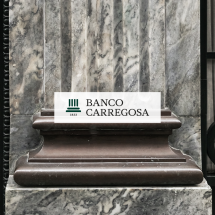- The Bank
- People
- All Services
- Private Banking
- Savings and Investment
- GoBulling Platforms
- Institutional and Corporate
- Insights
- Login My.BancoCarregosa
- Contacts
Enter your Username to gain access to your Bank. Complete your authentication on the next screen.
If you are not yet a client, open your account here or contact us for more information
The improbable beginnings of a private bank

It all began when Portugal was in the throes of civil war in 1833. We need to go back almost two centuries to trace how Banco Carregosa, the first private bank on the Iberian Peninsula, came into being.
It all began in the dramatic times of the Siege of Porto which lasted from July 1832 to August 1833. Although Banco Carregosa in its current form was officially founded on 19 June 2008, the bank traces its beginnings to 1833, the year in which the currency exchange house Sociedade António Joaquim de Sousa Bastos & Irmão was created. It preceded the Banco de Portugal, which was founded some 13 years later, in 1846. The foundation of the currency exchange house in 1833 gave rise to what is now Banco Carregosa. The bank had its origins in the midst of a bloody civil war, with Porto under siege and under fire.
The story of a private bank forged by iron and fire
This was the most dramatic period of the Siege. Trapped inside the city, seven thousand five hundred soldiers under the command of Dom Pedro IV, the constitutional king, faced the onslaught of the troops of Dom Miguel I.
The privations during this time were indescribably enormous. There was a shortage of everything. There was no food and the price of the few products that could still be found on the market had doubled and in some cases tripled.
So how, in the midst of this terror, did someone have the courage to found a currency exchange house?
A private bank with a resilient past
Despite hard fighting, famine and disease, life did not stop at all.
Tailors continued making coats and dresses; coppersmiths continued beating copper; tanners continued tanning leather, and lumber workers still cut and planed timber.
It was against this socio-economic backdrop that António Joaquim de Sousa Bastos founded the Sociedade António Joaquim de Sousa Bastos & Irmão with one of his brothers in 1833 to carry out the business of currency exchange and the sale of coupons and credit papers.
And it was probably no accident that António de Sousa Bastos opened his establishment in the aristocratic and opulent Rua das Flores which D. Manuel I had commissioned in 1518. It was also commonly known (although never officially) as Rua do Ouro due to the abundance of goldsmiths there.
Constant change – a key principle for a private bank
Today, in the same place where "Casa Carregosa" used to be, in Rua das Flores, it is still possible to admire the renovated, classically inspired façade, exactly where it all began almost two centuries ago.
The turning point came years later when Lourenço Joaquim Carregosa assumed the leadership of the Bank in 1885. It was a propitious moment. When it entered the last quarter of the 19th century, Portuguese society was eager to adopt everything that represented material progress, but they were also keen to seize the opportunity to have fun.
The rail link between Lisbon and Porto was completed in 1864. It heralded the beginning of a seemingly vast transport network that connected the country and facilitated the movement of goods, people and capital.
Banking in its infancy in Portugal
This was a time when lending —and banking— experienced rapid growth. In 1858, there were only three banks in the whole country. In 1865, there were 12. Ten years later, this number had grown to 51. The growth and prosperity of a vast middle class which was beginning to emerge were quite evident. The country was industrialising.
So, when Lourenço Joaquim Carregosa took over the management of the old currency exchange house, the country was prospering and catching up, in many respects, with the rest of Europe. But with growth came new responsibilities. In terms of development, therefore, the organisation accompanied the economic and social evolution of the society as a whole.
The beginning of a new phase
Manoel da Rocha e Silva quickly earned the trust of his peers in L. J. Carregosa because of his cultured manner, his natural aptitude for hard work, and the attention he vested in everything he did. In the 1960s, he joined the company as a shareholder. He became the great driving force behind the company which he served with exemplary dedication until his death on 7 March 1997. Together with his daughter, Maria Cândida da Rocha e Silva, he was instrumental in ensuring that Casa Carregosa survived several upheavals and modernised, and that it achieved the status of Bank.
The current Chair of the Board of Directors of Banco Carregosa, Maria Cândida da Rocha e Silva, was born in Vila do Conde in January 1944. In 1971, she began working with her father at Casa Carregosa. In 1981, she became the first woman to register as an official stockbroker of the Portuguese Stock Exchange, which began trading in 1961.
With the revolution of 25 April 1974, currency exchange houses were abolished. L. J. Carregosa was forced to shift focus. And that is what it did. But not without the ambition and determination that culminated in obtaining approvals for the establishment of the L. J. Carregosa - Sociedade Corretora S.A. brokerage in 1994.
What makes a private bank different?
In 2000, L. J. Carregosa launched the first online brokerage service in Portugal in partnership with Saxo Bank.
In 2007, the GoBulling online trading brand was launched, making L.J. Carregosa the first broker to offer zero brokerage commission on all Euronext markets. In that very same year, GoBulling became the market leader in the futures market.
But the lessons of a story that began when there were no computers, internet or smartphones are still very pertinent. The secret to long-term success lies in having a strong culture and a team of talented, diverse people. We are as committed today to making our resources available to clients to create, manage and distribute capital as we were in 1833.
We are building a more sustainable future for society, with a focus on future generations. In doing so, we rely on the principles on which Casa Carregosa was founded: independence, innovation, dynamism, transparency and concern for the client.
History has taught us the importance of this way of thinking. Today, almost 200 years later, our strategy is based on continuity, stability and sustainability for the lasting benefit of our clients.




















